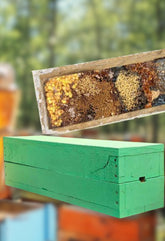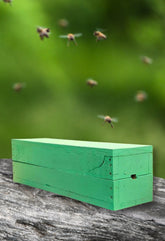Kera Herb – Stingless Bee Colony Setup Guide
🐝 A Beginner’s Guide to Keeping Stingless Bees

Key Differences from Honeybees:
-
No Stingers: Stingless bees are non-aggressive and cannot sting.
-
Low Maintenance: They require minimal intervention and are easy to manage.
2. Where and How to Keep Stingless Bees
-
Gardens: Place the hive near flowering plants for easy foraging.
-
Farms: Ideal for pollination in open fields, green net farms, and polyhouses.
-
Balconies/Rooftops: Ensure the hive is protected from direct sunlight and rain.
-
Shaded Areas: Keep the colony in a shaded spot to prevent overheating and melting of honey.
-
Direct sunlight can cause the honey inside the hive to melt, which can harm the bees.
-
A shaded area ensures the colony remains cool and productive.
3. Using Stingless Bees as Pollinators
-
Green Net Farms: Their small size allows them to navigate easily through nets.
-
Polyhouses: They thrive in covered environments and enhance pollination.
-
Home Gardens: They pollinate a wide variety of flowers, fruits, and vegetables.
4. Stingless Bees are Family-Friendly
5. Maintenance and Hive Management
Stingless bees are low-maintenance, but here are a few tips to ensure their well-being:
-
While opening the hive, wear a full-sleeve shirt and a bee veil to avoid any minor bites.
-
Use a smoker (optional) to calm the bees during hive inspections.
Hive Placement for Multiple Colonies:
6. Additional Tips for Success
-
Water Source: Provide a small water source near the hive, especially during hot weather.
-
Flowering Plants: Plant a variety of flowers to ensure a continuous food supply for the bees.
-
Avoid Pesticides: Use organic farming practices to protect the bees from harmful chemicals.
-
Regular Checks: Inspect the hive every few weeks to ensure the colony is healthy and active.
7. Benefits of Stingless Bees
8. Join the Stingless Bee Revolution
Frequently Asked Questions (FAQ)
1. What are stingless bees?
Stingless bees are small, social insects that belong to the tribe Meliponini. They are excellent pollinators and produce a unique type of honey. Unlike honeybees, they do not have stingers, making them safe and friendly for families.
2. How are stingless bees different from honeybees?
-
No Stingers: Stingless bees cannot sting, making them non-aggressive.
-
Smaller Colonies: Their colonies are smaller, with fewer bees.
-
Low Maintenance: They require minimal care and are easy to manage.
-
Unique Honey: Their honey, called keliphon honey, has a tangy flavor and medicinal properties.
3. Where should I keep my stingless bee colony?
Stingless bees can be kept in:
-
Gardens: Near flowering plants for easy foraging.
-
Farms: Ideal for pollination in open fields, green net farms, and polyhouses.
-
Balconies/Rooftops: Ensure the hive is protected from direct sunlight and rain.
-
Shaded Areas: Keep the colony in a shaded spot to prevent overheating.
4. How do I protect the hive from sunlight and rain?
-
Place the hive in a shaded area or under a roof.
-
Use a stand to elevate the hive or hang it on a tree.
-
Ensure the hive is covered to protect it from heavy rain.
5. Can I keep stingless bees in a polyhouse or green net farm?
Yes! Stingless bees are excellent pollinators for polyhouses and green net farms. Their small size allows them to navigate easily through nets and covered environments.
6. Are stingless bees safe for kids and pets?
Absolutely! Stingless bees are non-aggressive and rarely bite. Even if they do, it feels like a pinprick. They are safe to keep around children and pets.
7. Do I need special gear to handle stingless bees?
While stingless bees are gentle, it’s recommended to wear a full-sleeve shirt and a bee veil when opening the hive. This protects you from minor bites and ensures a smooth experience.
8. How do I manage multiple colonies?
-
Place hives with their entrances facing opposite directions to prevent bees from drifting into the wrong hive.
-
Maintain a distance of at least 3-5 meters between hives.
-
Ensure each colony has a queen bee, workers, and enough resources (honey and pollen).
9. Can I divide a stingless bee colony?
Yes, stingless bee colonies can be divided to create new hives. Ensure each new colony has a queen bee, workers, and sufficient resources to thrive.
10. How much honey does a stingless bee colony produce?
A single stingless bee colony produces about 1-2 kilograms of honey per year. While this is less than honeybees, their honey is highly valued for its unique flavor and medicinal properties.
11. What plants should I grow for stingless bees?
Stingless bees are generalist pollinators and visit a wide variety of flowers. Some great options include:
-
Fruits: Mango, guava, coconut, and citrus.
-
Vegetables: Eggplant, tomato, and cucumber.
-
Flowers: Marigold, sunflower, and hibiscus.
12. How do I protect stingless bees from pesticides?
-
Use organic farming practices to avoid harmful chemicals.
-
If pesticides are necessary, apply them in the evening when bees are less active.
13. What should I do if my colony seems weak or inactive?
-
Ensure the hive is in a shaded, undisturbed location.
-
Provide a water source and plant flowering plants nearby.
-
Contact Kera Herb for expert advice and support.
14. How can I buy a stingless bee colony from Kera Herb?
-
Visit our website: keraherb.com.
-
Call us at +91 95264 58775 for inquiries and orders.
-
Follow us on social media for updates and tips.
15. Do you provide guidance and support after purchase?
Yes! At Kera Herb, we are committed to your success. We provide:
-
Expert guidance on setting up and maintaining your colony.
-
Regular tips and updates via email or social media.
-
Customer support for any questions or concerns.
Still Have Questions?
Feel free to reach out to us at +91 95264 58775 or visit keraherb.com. We’re here to help you every step of the way!








